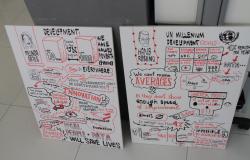
To what extent did the Millennium Development Goals (MDGs) succeed in becoming a reference point for public debates, academic inquiry, and policy‐focused research? We explore this by considering three empirical questions. First, were there discernible trends in the extent of media references to the MDGs – by year, publication, and geography over the relevant period? Second, were there discernible trends in MDG references across a sample of relevant academic journals and disciplines? Third, how does the pattern of MDG media references compare to the emerging early pattern of Sustainable Development Goal (SDG) media references? In our sample, we find that newspapers in the UK, India and Nigeria had much more frequent MDG references than those published in Australia, Canada or the United States. We also find that The Lancet had a notably high frequency of MDG‐referencing articles, potentially helping to explain the distinctive patterns of acceleration on health MDGs. We further find that UN summits were a key driver of MDG coverage, with 2005 as the year of peak MDG attention. News coverage for the SDGs in 2016 was similar to latter year coverage of the MDGs, although considerably higher than related coverage in 2001 and 2002.
Policy Implications
-
UN summits can play a measurable role in generating public debate around global policy goals.
-
Frequent MDG mentions in health‐focused academic journals coincided with accelerations in health progress. Policy makers can encourage similar applied research debate across SDG‐relevant disciplines.
-
Peer countries aiming to learn from UK government policy advances during the 2000s should consider MDG media coverage for context.
-
Indian and Nigerian newspapers have had high rates of MDG and SDG mentions, countering notions that discourses are concentrated in developed countries.
-
Multilateral development banks paid limited research attention to the MDGs and could generate intensified research for the SDGs.